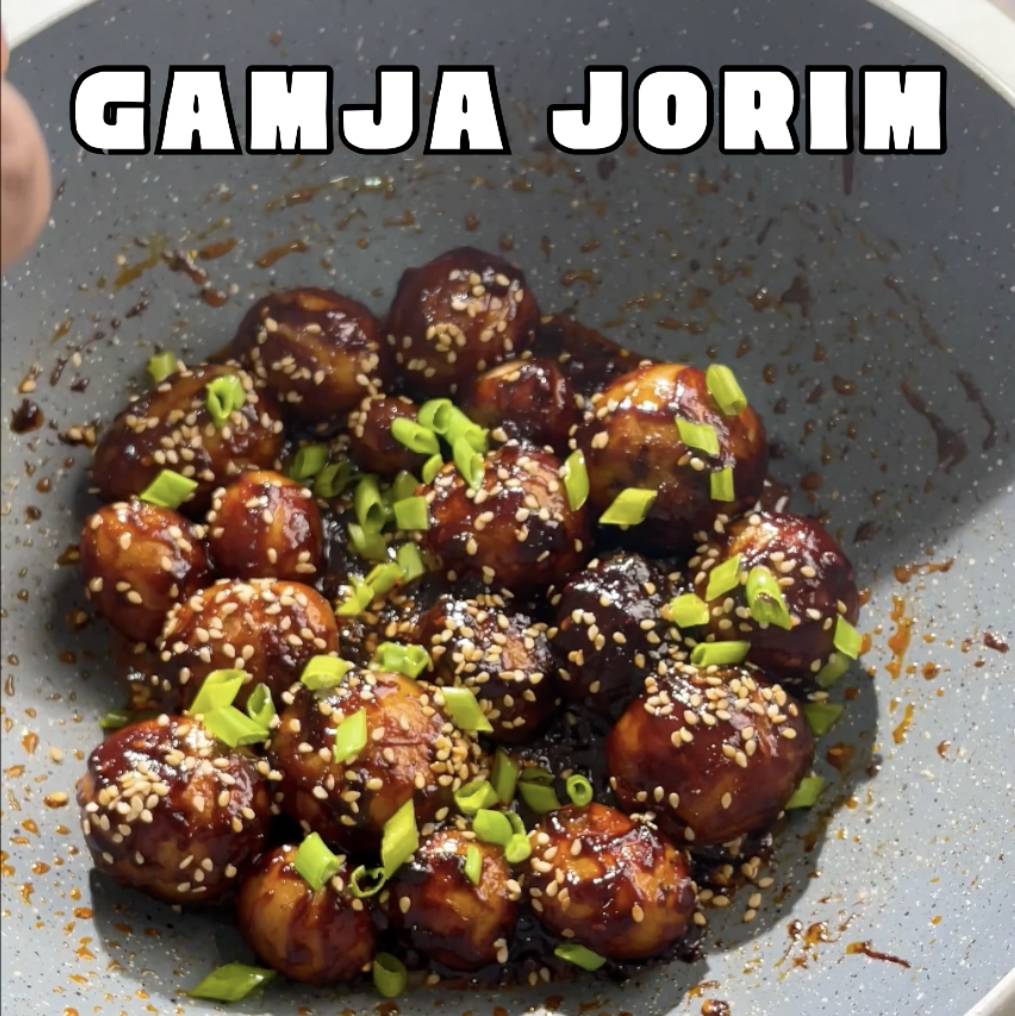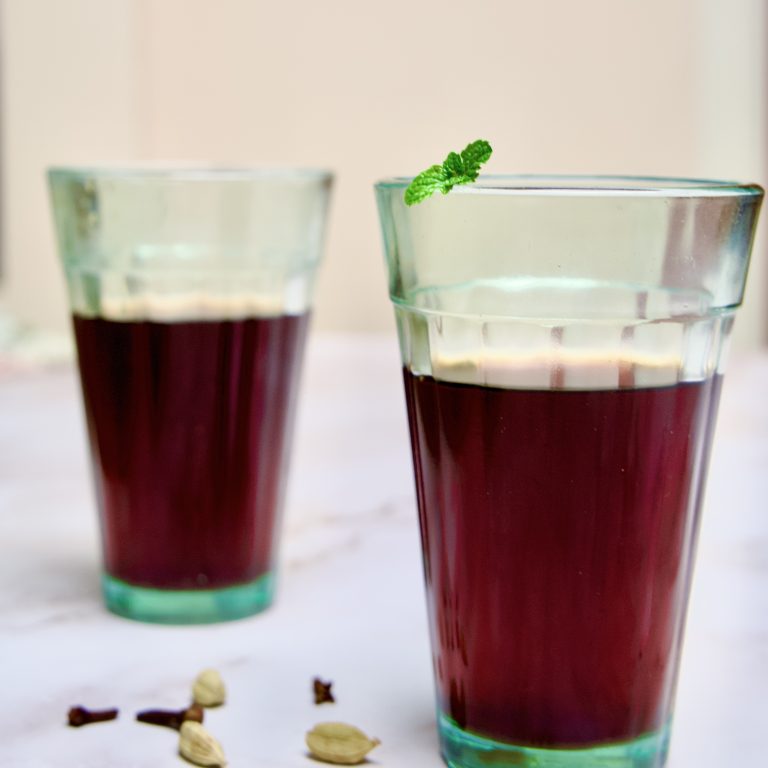Gamja Jorim [????]
Sticky, salty taters- pure fire!

Korean Braised Potatoes:
If you’ve ever dined at a Korean restaurant or enjoyed a traditional home-cooked meal in Korea, you’ve probably encountered Gamja Jorim (감자조림). This delicious Korean braised potato dish is a staple in Korean cuisine and is commonly served as part of a banchan (Korean side dish) spread.
The name Gamja Jorim breaks down into:
- Gamja (감자) – meaning potato in Korean.
- Jorim (조림) – meaning braised or simmered dish.
This dish features baby potatoes slowly simmered in a savory, slightly sweet, and mildly spicy glaze made from soy sauce, gochujang, honey (or date syrup for a vegan version), and sesame oil. The result? Soft, flavorful potatoes coated in a glossy, umami-rich sauce that pairs beautifully with a bowl of warm rice.
Unlike French fries or mashed potatoes, this dish highlights potatoes in their whole, naturally creamy form with a rich, caramelized glaze. It’s comforting, easy to prepare, and perfect for meal prep, as the flavors develop even more after resting.
Key Ingredients
Main Ingredients:
- Baby Potatoes (200g) – Small, waxy potatoes work best because they hold their shape while absorbing the sauce. If using larger potatoes, cut them into equal-sized chunks for even cooking.
- Garlic (2 cloves, sliced or chopped) – Adds depth and a rich aroma to the dish. Korean cooking often includes lots of garlic for bold flavors.
- Oil or Butter (2 tbsp) – Used for lightly pan-frying the potatoes before braising, which enhances their texture. Butter adds richness, while oil keeps it plant-based.
- Water (2-3 cups) – Needed to simmer the potatoes until they become soft and tender.
For the Sauce:
- Soy Sauce (1 tbsp) – The foundation of the sauce, providing umami, saltiness, and depth.
- Gochujang (3 tsp) – Korean fermented chili paste that adds a mild kick, smokiness, and a touch of sweetness. Adjust the quantity based on spice preference.
- Honey or Date Syrup (3 tsp) – Balances the savory elements with natural sweetness. Use date syrup or maple syrup for a vegan-friendly option.
- Water (3 tbsp) – Helps blend the sauce and ensures even coating.
- Sesame Oil (1 tsp) – Gives the dish a nutty, aromatic finish that is essential in Korean cuisine.
Garnishes:
- Spring Onion (1 chopped stalk) – Adds freshness and color contrast to the final dish.
- Sesame Seeds (½ tsp) – A final touch that enhances texture and nuttiness.
How to Make Gamja Jorim
1. Prepare the Potatoes
- Thoroughly wash the baby potatoes to remove dirt. If using large potatoes, peel and cut them into 1-inch cubes.
- Heat 2 tbsp of oil or butter in a pan over medium heat.
- Add the potatoes and sliced garlic, stirring occasionally. Sauté for 5–7 minutes until the potatoes are lightly golden on the outside.
2. Simmer the Potatoes
- Pour 2-3 cups of water into the pan, ensuring the potatoes are fully submerged.
- Bring the water to a boil, then reduce to medium-low heat and let it simmer.
- Cook for 15-20 minutes or until the potatoes are fork-tender. If the water level reduces too quickly, add a bit more to keep them submerged.
3. Prepare the Sauce
- In a small bowl, whisk together:
- 1 tbsp soy sauce
- 3 tsp gochujang
- 3 tsp honey or date syrup
- 3 tbsp water
- 1 tsp sesame oil
- Adjust flavors to your liking—add more honey for sweetness, gochujang for spice, or soy sauce for more umami.
4. Braise the Potatoes
- Once the potatoes are tender, drain most of the water, leaving about ½ cup in the pan.
- Pour the prepared sauce over the potatoes and stir well to coat them evenly.
- Let them simmer on low heat for 5-7 minutes, stirring occasionally until the sauce thickens into a glossy glaze.
5. Garnish and Serve
- Sprinkle chopped spring onions and ½ tsp sesame seeds on top.
- Serve warm as a side dish alongside Korean BBQ, kimchi, or steamed rice.
Tips and Variations
- Control the Spice Level – Reduce gochujang for a milder version or add red pepper flakes for extra heat.
- Sweeter Flavor – Increase the honey or date syrup if you prefer a more caramelized, slightly sweet glaze.
- Crunchier Texture – For a crispy touch, pan-fry the potatoes for an extra 3–5 minutes before adding the sauce.
- Enhance the Sauce – Add a splash of rice vinegar for slight tanginess or a dash of black pepper for more depth.
- Protein Additions – Toss in boiled quail eggs, tofu cubes, or even tempeh to make this dish more filling.
Tips for Success
- Use Waxy Potatoes – They hold their shape better during braising and don’t become mushy.
- Don’t Overcook the Potatoes – Simmer until just fork-tender, as they will continue absorbing sauce in the final step.
- Keep an Eye on the Sauce – The glaze should be thick but not sticky. If it gets too thick, add a spoonful of water.
Customizable Variants
- Kid-Friendly Version – Reduce or omit gochujang and replace it with ketchup or a mild soy glaze for a less spicy option.
- Soy-Free Alternative – Swap soy sauce with coconut aminos or tamari for a soy-free version.
- Gluten-Free Version – Use gluten-free tamari or liquid aminos instead of soy sauce.
- Extra Vegetables – Mix in carrots, bell peppers, or mushrooms for added nutrition and variety.
Pro Tips for Meal Prep
- Make Ahead – Gamja Jorim tastes even better the next day as the flavors continue to develop. Store in an airtight container in the fridge for up to 3 days.
- Reheating Tip – When reheating, add a splash of water to loosen the sauce and prevent dryness.
- Batch Cooking – Double the recipe and store portions for quick, ready-to-eat side dishes throughout the week.
Final Thoughts
Gamja Jorim is comfort food at its best—simple, flavorful, and satisfying. Whether you enjoy it as a banchan with a Korean meal or as a quick snack with rice, this dish delivers a perfect balance of sweet, savory, and spicy flavors. Plus, it’s highly customizable to suit your preferences.
Try making Gamja Jorim at home, and let me know how it turns out!

![Teriyaki Tofu [??????]](https://seycooks.com/wp-content/uploads/2025/01/Tofu-Teriyaki-e1739289731779-768x769.png)




